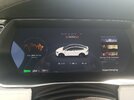Is this normal? I had the pleasure of having a 2017 P100D with ludicrous plus. The car has around 11k miles with every available option.
At full capacity, the battery is at 265 miles. Here's the issue- it took exceedingly long to charge. It was 70 degrees out and I drove 30 minutes to get to the supercharger.
I went to a supercharger and was the only car there. I started at 126 miles and after an hour, I was at 262 miles. It took 22 minutes for the first 88 miles, from 126 to 206, then another 40 minutes to get to 262 miles.
Another time charging, I was at 204 miles, and it took 28 minutes to get to 254 miles.
Is this car supposed to supercharge this slowly? I would need to stop for an hour to charge 125 miles. That doesn't seem right. And, 100 miles was more like 80 miles and that was going 55 mph on the highway or slower on local roads.
It seems like I couldn't go more than 200 miles away and return home to charge. Is this normal? I loved the car, but this seemed ridiculous.
I asked a few people at Tesla, over the phone and in person, and Tesla knows nothing about Tesla
Thanks.


At full capacity, the battery is at 265 miles. Here's the issue- it took exceedingly long to charge. It was 70 degrees out and I drove 30 minutes to get to the supercharger.
I went to a supercharger and was the only car there. I started at 126 miles and after an hour, I was at 262 miles. It took 22 minutes for the first 88 miles, from 126 to 206, then another 40 minutes to get to 262 miles.
Another time charging, I was at 204 miles, and it took 28 minutes to get to 254 miles.
Is this car supposed to supercharge this slowly? I would need to stop for an hour to charge 125 miles. That doesn't seem right. And, 100 miles was more like 80 miles and that was going 55 mph on the highway or slower on local roads.
It seems like I couldn't go more than 200 miles away and return home to charge. Is this normal? I loved the car, but this seemed ridiculous.
I asked a few people at Tesla, over the phone and in person, and Tesla knows nothing about Tesla
Thanks.
Attachments
Last edited:



